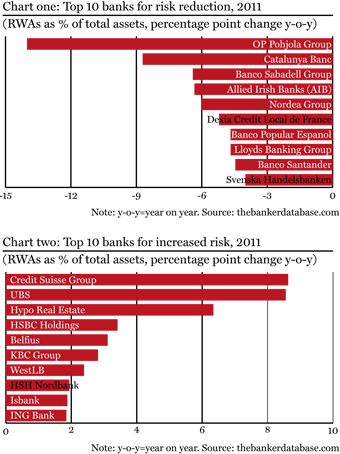European banks have been under pressure to deleverage to comply with new capital regulations and absorb losses. But many have reduced the risk in their balance sheet, rather than shrinking total assets.
The introduction of stress-testing and new capital requirements by the European Banking Authority in 2011 accelerated the process that had already been in place since 2008: shrinking the balance sheets of many European banks. Losses on eurozone periphery assets drove that process still further.
However, bank regulations create more than one way to shrink. Selling part of a bank’s portfolios is the most obvious method, but hardly an attractive one in a falling market. As capital is measured as a proportion of risk-weighted assets (RWAs) rather than just gross assets, the alternative method is to reduce risk even while the total size of the balance sheet remains steady.
This seems to be the prevailing tendency among the 75 largest European banks for which data is available. In total, 43 of them reduced gross total assets in 2011, but by contrast, 50 managed to lower their RWAs. On average, total assets fell by 1.26% across the sample, whereas RWAs fell by 4.2%.
The effect of this change is that RWAs are becoming a smaller proportion of total assets at many banks. These banks are derisking their balance sheets, rather than deleveraging. This is not a concern if banks are genuinely engaged in changing their asset mix. Among the top 10 banks by risk reduction, Ireland’s AIB and the UK’s Lloyds are both engaged in significant restructuring programmes that involve reducing their exposures to financial markets and troubled commercial real estate.
By contrast, the presence of four Spanish banks among the top 10 might raise a few eyebrows, even taking into account the global footprint of Banco Santander. Default rates in Spain are rising and it is not easy for Spanish banks to sell troubled exposures in their home market without taking significant losses. The presence of two Swedish banks, Nordea and Handelsbanken, is also interesting. Swedish regulators have been some of the strongest advocates of a tough leverage ratio – which focuses on the pure proportion of capital to assets, without the risk-weighting process. This suggests that the Swedish authorities may be a little sceptical of the rapid derisking process.
At the other end of the scale, the tougher approach to regulating financial market exposures under new Basel regulations is clearly visible on the balance sheets of Credit Suisse and UBS. These two banks saw the largest rises in RWAs as a proportion of total assets during 2011. Other banks in this group, such as Hypo Real Estate, were reducing assets sharply. The growing proportion of RWAs to total assets suggests they have found it more difficult to divest riskier holdings. Finally, the change in Turkey’s Isbank has a more conventional explanation. The Turkish market still has very low default rates, but slowing domestic economic growth has prompted prudent Turkish banks to increase the risk weights on their portfolios.



